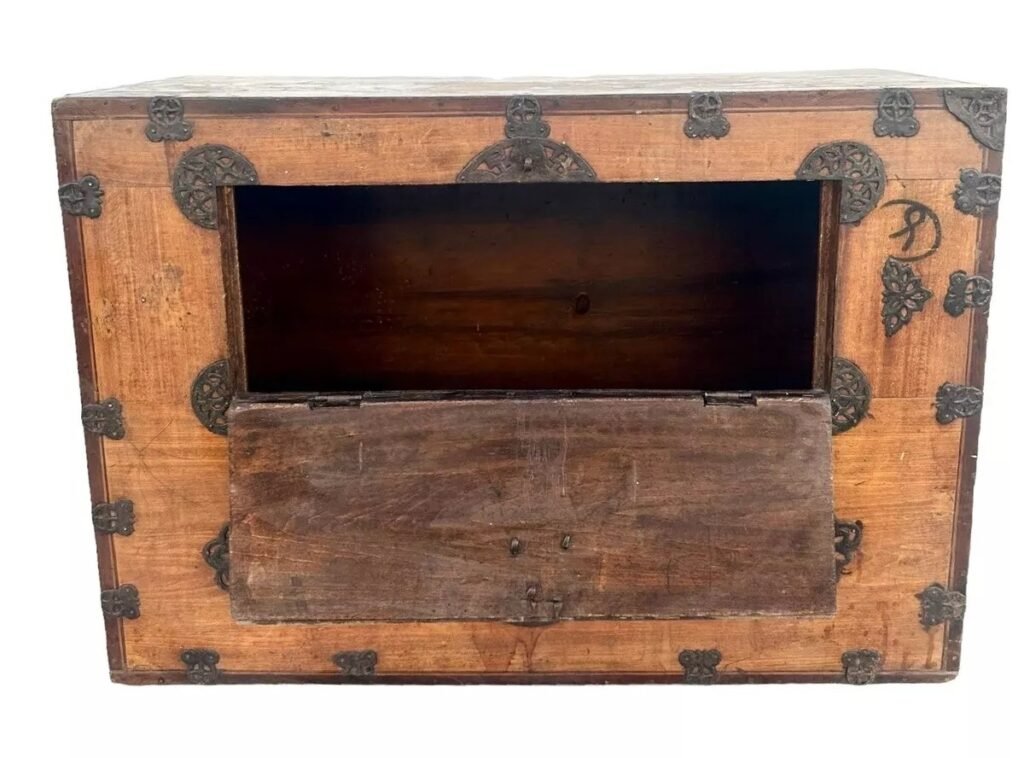If you wish to know more about your items, and want us to examine your pictures and give you more detailed information about your item origin, or if your item is real antique or not, Do not hesitate to contact us by email at: tortuebangkok@gmail.com.
Send us photos to assist in identifying your pieces. Precise identification from photos is a delicate operation. Therefore, try to send us 3 or 4 photos showing the front, sides, and the open piece of furniture as seen on the featured image of this publication.
Hi all, what do you think about this chest? Also, I wonder whether the supports underneath were originally part of it? H: 47cm, W: 70, D: 32,5cm. Thanks for your insights! Hendrik Gheerardyn.



This chest is called a ‘Beoseonjang’ and was used to store small clothing such as socks. It’s made from red pine wood with original iron cast fittings. The leg design was common for this type of piece. The chest appears to have been cleaned but still retains a nice patina. It’s probably dated from the early to mid-20th century. Hereunder two photos of a similar chest in Korea.


CASES OF RECONSTRUCTED FURNITURE
I knew nothing about it but it absolutely intrigued me and I had to have it. I thought it would complement my Chinese money chest that is also elm. After researching, I realized it is Korean and not Chinese. I’ve been down a rabbit hole to find out more about it, but if anyone can give me more insight on this particular bandaji, I would be greatly appreciative. Stephen Butcher.



Description to be published soon
I just acquired what I believe to be an antique Jeolla bandaji. I was so intrigued by the woods, the Korean newspaper lining and silk on front door panel inside. Can anyone help with type of chest, possible age, region and wood? The hardware is remarkable. Sheila Marie Rivera.

Due to the design of the hinges and its rather large size, this Bandaji is typical of the Jeolla Do province, particularly the Yeonggwang area. However, certain details reveal that it has undergone extensive restoration. Additional photos provided by Sheila Marie Rivera allow us to better identify it. Constructed in pine (sides, back and top), the front has been completely modified by the creation of maple panels inserted in elm frames with dark persimmon wood inlays, which is unusual for this particular type of furniture. The hinges, though attractive, are of recent manufacture, and the blackened shadows around them reveal restoration work in an attempt to reproduce a classic patina. The type of base on which it rests was never used on Bandaji, but rather on “Jangs” or multi-levels clothing chests.

Photos above & right. Back and top of the furniture: Pine wood.


Photos above and right. New iron fittings. The blackened shadows around them reveal restoration work in an attempt to reproduce a classic patina

The paper covering the interior is from old newspapers with Japanese characters, which may indicate a production date during the Japanese occupation of Korea (1910-1945).


We believe that this piece of antique furniture has been extensively restored and altered, and unfortunately cannot be considered an original.
TWO-LEVEL CHEST.
Bought this in a on-line auction for 350 €. Hit or miss? Any age? Bought it as a vintage Korean chest. Henry Forsström





This chest is called “Ich’ung Jang” in Korea – 이층장. “Ich’ung” means two levels, and “Jang” is the Korean name for a cabinet. It was mainly used to store clothing in a women’s quarter. Made of pine and probably elm front panels with square-shaped white brass fittings. Drawer pullers with bat design. It has been widely restored and, as mentioned, would be classified as a vintage piece (from the mid to late 20th century). Two details struck us: the presence of a second row of drawers in the middle part. The original two-level chest only featured one row of drawers on the top of the cabinet, and two different drawer pulls designs were used. Usually, the same type of fittings was used on one chest.
Photo under an older similar piece from the Andong city Folk museum on Gyeongsang Do province in Korea. Probably early 20th century.

I found a top part to a chest today. It needs some metal repairs which I will attend to but is this chest Korean or Japanese? The iron metal work is very interesting? Can you determine the age? Susan from Memphis.


This small chest is called a “Beoseonjang” (애기 버선장) in Korean and was mainly used to store small pieces of clothing such as socks. The front opening panel is of the Bandaji type, with its opening downward, but it doesn’t extend all the way. The fittings, though some are missing, seem to be original (Hwanghae province style). The type of wood (linden?) is difficult to identify with certainty, as this box seems to have been stained and badly restored, evident from its glossy finish. It likely dates from the early 20th century.

